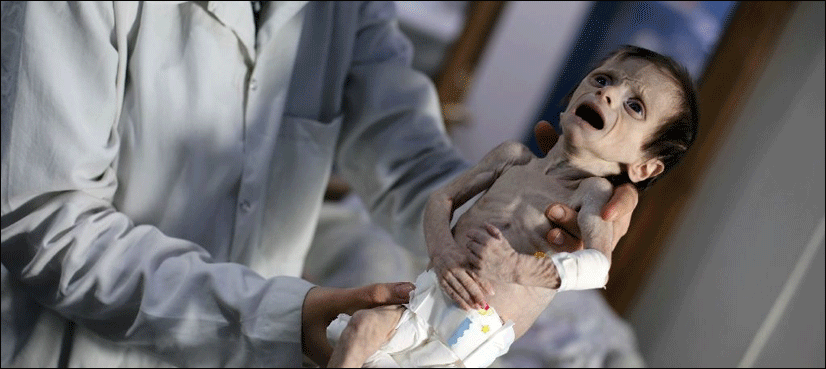HAMOURIA, Syria: One-month-old Sahar, her ribs protruding under translucent skin, breathed her last on Sunday in Syria’s Eastern Ghouta, where a crushing regime siege has pushed hundreds of children to the brink of starvation.
Only a trickle of humanitarian aid ever reaches this rebel-held region east of Damascus, under a tight blockade by Assad regime forces since 2013.
Eastern Ghouta is one of four “de-escalation zones” set up in May under a deal between backers of rival sides in Syria’s devastating six-year war.
But food supplies still rarely enter the region, where medical officials say hundreds of children are suffering acute malnutrition.
On Saturday, the parents of Sahar Dofdaa, just 34 days old, took her to a hospital in the Eastern Ghouta town of Hamouria.
Read More: Islamic State group loses emblematic Syria stronghold Raqqa
Images filmed by a reporter working with AFP showed a wide-eyed girl with listless eyes and little but skin on her bones.
She tried to cry but lacked the strength to make much of a noise. Her young mother sobbed nearby.
Her skeletal thighs poked out of a nappy way over her size. Placed on the scales, she weighed less than two kilogrammes (just over 4 pounds).
Like hundreds of children in Ghouta, Sahar was suffering from acute malnutrition.
Her mother was too undernourished to breastfeed her and her father, earning a pittance at a butcher’s shop, was unable to afford milk and supplements.
Read More: Turkish forces launch incursion into Syria
Sahar died at the hospital on Sunday morning and her parents took her — their only child — to their nearby town of Kafr Batna to bury her.
Her death came after another child in Ghouta also died of malnutrition on Saturday, the Syrian Observatory for Human Rights said.
“Residents suffer from severe food shortages, and when goods are available in the markets, it’s at a crazy price,” the Observatory said.

Ghostly faces
Medics at hospitals and health clinics in Eastern Ghouta say they examine dozens of malnourished children a day — and that the number is on the rise.
Images taken by an AFP correspondent show skeletal infants with ghostly faces.
One has breathing difficulties, another has a feeding tube in its mouth and a third has a bandage wrapped around his tiny arm.
Yahya Abu Yahya, doctor and regional head of medical services for Turkish NGO Social Development International, which has several medical centres in Ghouta, said the group’s centres had examined 9,700 children in recent months.
“Of these, 80 were suffering severe acute malnutrition, 200 had moderate acute malnutrition, and about 4000 were suffering from nutritional deficiencies,” he said.
The UN children’s fund UNICEF defines “severe acute malnutrition” as the most extreme and visible form of undernutrition.
“Its face is a child — frail and skeletal — who requires urgent treatment to survive,” it says.
Abu Yahya said that many children in Eastern Ghouta are suffering from “deficiencies, migraines, vision problems, depression, psychological problems”.
Read More: Israeli defence minister says Syria’s Assad ‘victorious’
According to UN figures, some 400,000 people live in besieged parts of Syria, the majority in Eastern Ghouta.
Despite agreement on de-escalation zones backed by regime supporters Russia and Iran and rebel sponsor Turkey, the region still has very limited access to aid.
Abu Yahya said the region was not receiving basic foods children need, such as sugar, sources of protein and vitamins.
On September 23, a convoy carrying food and medical aid for some 25,000 people entered three besieged areas of Eastern Ghouta, according to the UN.
But Abu Yahya said what aid does reach the region covers just five to 10 percent of the needs of malnourished children.
Sahar was the latest victim of Eastern Ghouta’s food crisis.
On Sunday, her father carried the tiny child to her grave. Behind him, relatives walked with Sahar’s mother, nearly collapsing with grief.


Leave a Comment